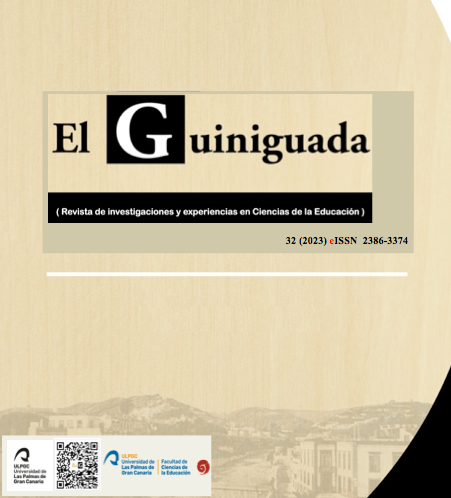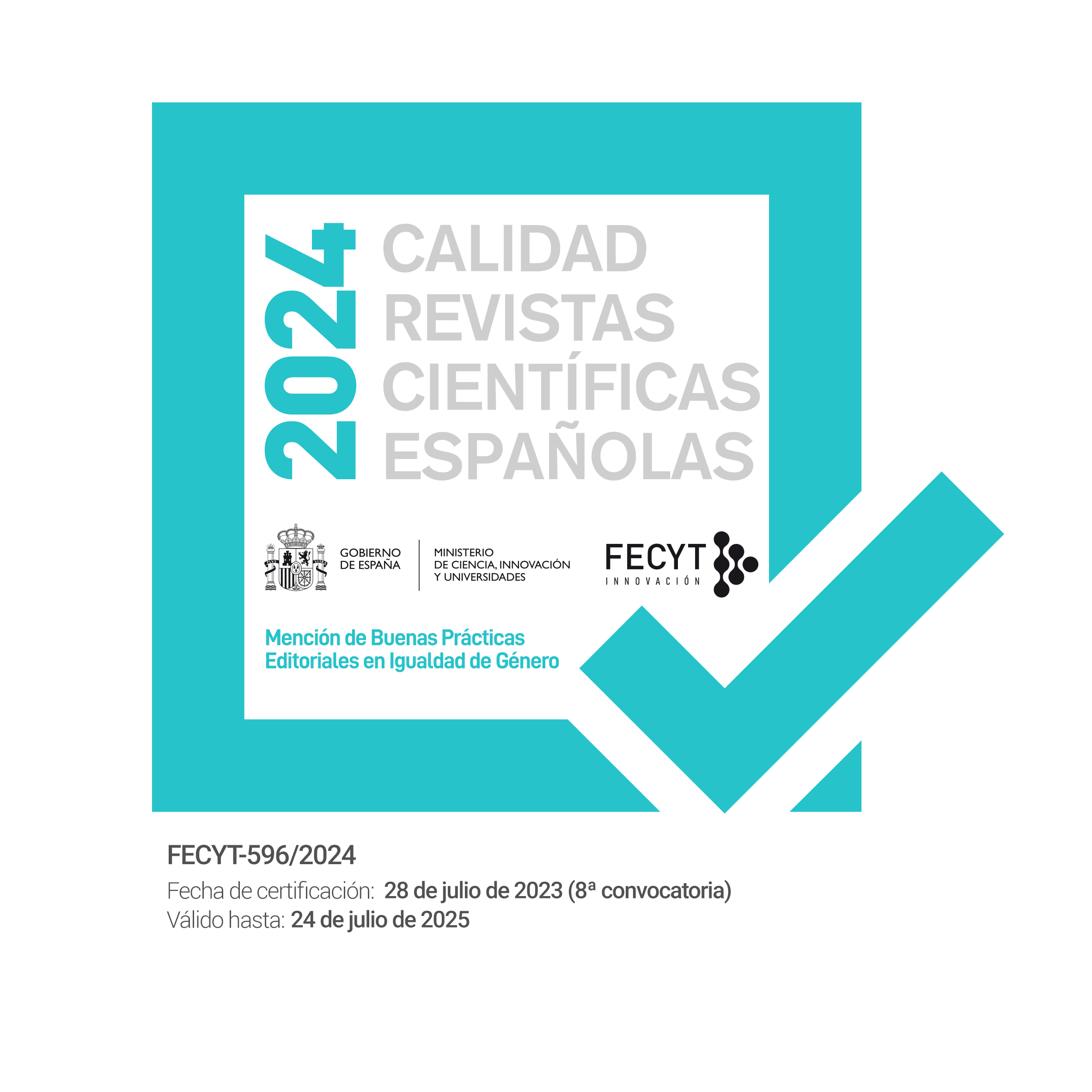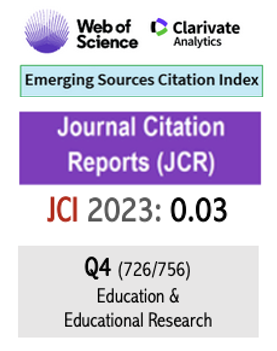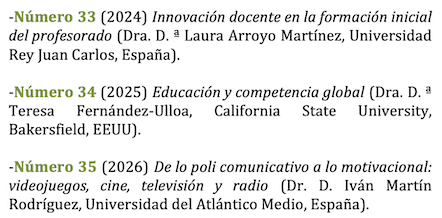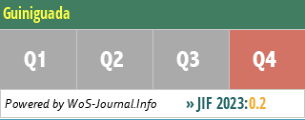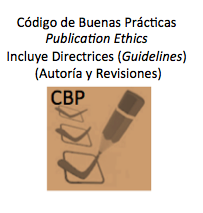opinión de las familias sobre el programa bilingüe de la Comunidad de Madrid. Parents´opinion about the bilingual program in the Autonomous Community of Madrid
10.20420/ElGuiniguada.2023.631
Keywords:
OPINION, FAMILIES, BILINGUAL PROGRAM, MADRID COMMUNITYAbstract
The aim of this article is to understand the opinion and the level of satisfaction of the families of the bilingual program of the Madrid Community. Therefore, in this study 444 families of primary school students, who follow bilingual studies (English/Spanish), in 5 public schools, situated in Madrid, have participated. For this study the data have been collected in an anonymous way, through a survey which has been completed by the families. The main results show that: families and children are highly satisfied with the bilingual program, the English level of the students improves, teachers, students and parents make an extra effort to make the bilingual program work, the English level of the parents is crucial to be able to help their children, and the content of History or Natural Sciences is not learnt at the same level as in monolingual educational centers.
Downloads
References
Alonso Somarriba, L. (10 de marzo de 2012). La enseñanza bilingüe. El País. Recuperado de https://elpais.com/elpais/2012/03/09/ opinion/1331319372_387330.html
Baker, C., Campoy, F. I. y Ada, A. (2017). Guía Para Padres de Niños Bilingües. Bristol: Multilingual matters. https://doi.org/10.21832/ ADA 7913.
Berger, A. (2016). Learning mathematics bilingually. An Integrated Language and Mathematics Model (ILMM) of word problem solving processes in English as a foreign language. En T. Nikula, E. Dafouz, P. Moore y U. Smit (Eds.), Conceptualising Integration in CLIL and Multilingual Education (pp. 73-100). Bristol: Multilingual Matters.
Brindusa, A., Cabrales, A. y Carro, J. M. (2013). Evaluación de un programa de educación bilingüe en España: el impacto más allá del aprendizaje del idioma extranjero. Fundación de Estudios de Economía Aplicada, Documento de trabajo 2013/08. Recuperado de http://documentos.fedea.net/pubs/dt/2013/dt-2013-08.pdf
Bialystok, E. (2004). The impact of bilingualism on language and literacy development. En T. Bhatia y W. Ritchie (Eds.), The Handbook of Bilingualism (pp. 577-601). Oxford: Blackwell.
Bialystok, E. (2005). Consequences of bilingualism for cognitive development. En J. Kroll, y A. De Groot, The Handbook of Bilingualism: Psycholinguistic Approaches (pp. 417-431). Oxford: Blackwell.
Cabezas Cabello, J. M. (2010). A SWOT Analysis of the Andalusian Plurilingualism Promotion Plan (APPP). En M. L. Pérez Cañado (Ed.), Proceedings of the 23rd GRETA Convention (pp. 83-91). Jaén: Joxman.
Carro, J. M., Cabrales, A. y Anghel, B. (2016). Evaluating a bilingual education program in Spain: the impact beyond foreign language learning. Economic Inquiry, 54(2), 1202-1223.
Chaieberras, Z. (2019). Parents´ perspectives on the bilingual program in the region of Madrid. Pulso. Revista de Educación, 42, 73-105.
Chaieberras, Z., y Rascón-Moreno, D. (2018). Perspectives of Compulsory Secondary Education Students on Bilingual Sections in Madrid (Spain). English Language Teaching, 11 (10), 152-161. https://doi.org/10.5539/elt.v11n10p152.
Coleman, J. S., Campbell, E. Q., Hobson, C. J., McPartland, J., Mood, A. M., Weinfeld, F. D. y York, R. L. (1966). Equality of Educational Opportunity. Washington, DC: US Department of Health, Education & Welfare. Office of Education.
Cordero, J. M., Crespo, E. y Pedraja, F. (2013). Rendimiento educativo y determinantes según PISA: Una revisión de la literatura en España, Revista de Educación, 362, 273-297.
Doiz, A., Lasagabaster, D., y Sierra, J. M. (2014). CLIL and motivation: the effect of individual and contextual variables. The Language Learning Journal, 42 (2), 209-224.
Dale, L., y Tanner, R. (2012). CLIL Activities. A Resource for Subject and Language Teachers. Cambridge: Cambridge University Press.
Dalton-Puffer C. (2007). Discourse in Content and Language Integrated Learning (CLIL). Amsterdam-Philadelphia: John Benjamins Publishing Company. http://doi.org/10.1075/lllt.20
De Smet, A., Mettewie, L., Galand, B., Hiligsmann, P., y Van Mensel, L. (2018). Classroom anxiety and enjoyment in CLIL and non-CLIL: Does the target language matter? Studies in Second Language Learning and Teaching, 8 (1), 47-71.
Esparza, C. M. y Belmonte, M. L. (2020). Percepción docente sobre el bilingüismo en centros de Educación Infantil y Educación Primaria de la Región de Murcia. Revista Complutense de Educación, 31 (2), 251-260. http://dx.doi.org/10.5209/rced.63130
Falcón, E., y Lorenzo, F. (2015). El desarrollo de la sintaxis compleja en L1y L2 en entornos educativos bilingües (CLIL). Un estudio de caso. E-Aesla, 1, 1-9.
Fernández-Sanjurjo, J., Fernández-Costales, A., y Arias Blanco, J. M. (2017). Analysing students’ content-learning in science in CLIL vs. Non-CLIL programmes: empirical evidence from Spain. International Journal of Bilingual Education and Bilingualism, 1-14. https://orcid.org/10.1080/13670050.2017.1294142.
Geoghegan, L. (2018). International posture, motivation and identity in study abroad. En Pérez-Vidal, C., López-Serrano, S., Ament, J. y ThomasWilhelm, D. J. (Eds.). Learning context effects: Study abroad, formal instruction and international immersion classrooms (pp.215- 253). Berlín: Language Science Press.
Hajer, M. (2000). Creating a language-promoting classroom: content-area teachers at work. En J. K. Hall, and L. Stoops Verplaetse (Eds.) Second and foreign language learning through classroom interaction (pp. 265-285). Mahwah N.J. and London: Lawrence Erlbaum Associates.
Halbach, A. (2009). The primary school teacher and the challenges of bilingual education. En E. Dafouz y M.C. Guerrini (Eds.), CLIL Across Educational Levels (pp. 19-26). Madrid: Richmond Publishing.
Hernández Prados, M. A., Gambín Martínez, M.J. y Tolino Hernández-Henarejos, A. C. (2018). La percepción de las familias ante la enseñanza de segundas lenguas. Revista Fuentes, 20(1),11-27. http://dx.doi.org/10.12795/revistafuentes.2018.v20.i1.01
Hosseinpour, V., Sherkatolabbasi, M. y Yarahmadi, M. (2015). The impact of parents’ involvement in and attitude toward their children’s foreign language programs for learning English. International Journal of Applied Linguistics and English Literature, 4(4), 175-185.
Lancaster, N. (2016). Stakeholder perspectives on CLIL in a monolingual context. English Language Teaching, 9 (2), 148-177. https://doi.org/10.5539/elt.v9n2p148
Lasagabaster, D. (2011). English achievement and student motivation in CLIL and EFL settings. Innovation in Language Learning and Teaching, 5(1), 3-18.
López Peinado, M. E. (2018). Estudio longitudinal del programa de enseñanza bilingüe CBM en un centro docente de Educación Primaria de la Región de Murcia (Tesis Doctoral). Universidad de Murcia, Murcia, España.
Lorenzo, F., Casal, S., y Moore, P. (2009). The Effects of Content and Language Integrated Learning in European Education: Key Findings from the Andalusian Bilingual Sections Evaluation Project. Applied Linguistics, 31 (3), 418-442. http://dx.doi.org/10.1093/applin/amp041
Louise Oxbrow, G. (2018). Students’ Perspectives on CLIL Programme Development: A Quantitative Analysis. Porta Linguarum, 29, 137-158.
Madrid, D. (2010). El contexto social del alumnado y su relación con el rendimiento en lengua extranjera, en M. Falces, E. Hidalgo, J. Santana y S. Valera (eds.), Para, por y sobre Luis Quereda. Granada: Editorial Universidad de Granada, 519-533.
Martín-Macho, A., y Faya, F. (2020). L1 in CLIL: the case of Castilla-La Mancha. Revista Tejuelo, 31, 143-174. https://doi.org/10.17398/1988-8430.31.143.
Mehan, H. (1991). Sociological foundations supporting the study of cultural diversity. Disponible en: http://escholarship.org/uc/item/0xb777zn.pdf, accessed 8 May 2017.
Milla Lara, M. D., Casas Pedrosa, A. V. (2018). Teacher Perspectives on CLIL Implementation: A Within-Group Comparison of Key Variables. Porta Linguarum, 29, 159-180.
Mohan, B. (1986). Language and Content. Reading, MA: Addison-Wesley.
Murillo, F. J., Almazán, A. y Martínez-Garrido, C. (2021). La elección de centro educativo en un sistema de cuasi-mercado escolar mediado por el programa de bilingüismo. Revista Complutense de Educación, 32 (1), 89-97. http://dx.doi.org/10.5209/rced.68068
Nieto Moreno de Diezmas, E. (2016). The Impact of CLIL on the Acquisition of the Learning to Learn Competence in Secondary School Education in the Bilingual Programmes of Castilla-La Mancha. Porta Linguarum, 25, 21-34.
Nieto Moreno de Diezmas, E. y autor (2018).
Nyholm, L. (2002). Läsa på engelska. Språkvård, 3, 38-39.
Pérez Serrano, G. (1981). Origen social y rendimiento escolar. Madrid: Centro de investigaciones sociológicas.
Pérez-Vidal, C. (2013). Perspectives and Lessons from the Challenge of CLIL Experiences. En C. Abello-Contesse, P. M. Chandler, M. D. López-Jiménez, y R. Chacón-Beltrán (Eds.), Bilingual and Multilingual Education in the 21st Century. Building on Experience, (pp. 59–82). Bristol: Multilingual Matters.
Ráez-Padilla, J. (2018). Parent Perspectives on CLIL Implementation: Which Variables Make a Difference? Porta Linguarum, 29, 181-196.
Ródenas, J. A. (2016). La educación bilingüe en la Comunidad Autónoma de la Región de Murcia: influencia en la creatividad, rendimiento y motivación académica del alumnado de Educación Primaria (Tesis Doctoral). Universidad de Murcia, Murcia, España.
Ruiz, M. (2016). Bilingual Education: Experience from Madrid (Tesis de Maestría). Centro de Estudios Monetarios y Financieros (CEMFI), Madrid. http//doi.org/10.21832/9781783096701-011.
Ruiz, M. (2018) Assessing English Writing Skills of Students from Bilingual and Non-Bilingual Schools in Castilla-La Mancha, Spain. A Comparative Study. Theory and Practice of Second Language Acquisition, 5 (2), 95–113. https://doi.org/10.31261/tapsla.7658
Ruiz, M. (2021). Nivel de satisfacción del alumnado sobre los programas de enseñanza bilingüe en Castilla-La Mancha. Tejuelo, 33, 159-190. https://doi.org/10.17398/1988-8430.33.169
Ruiz de Zarobe, Y. (2013). CLIL implementation: From policy-makers to individual initiatives. International Journal of Bilingual Education and Bilingualism, 16 (3), 231-243. https://doi.org/10.1080/13670050.2013.777383
Ruiz de Miguel, C. (2009). The effective schools: A multilevel study of explanatory factors of the school performance in the area of mathematics, Revista de Educación, 348, 355-376.
Sanmartín, O. (18 de diciembre de 2013). La educación bilingüe en inglés ralentiza el aprendizaje de Conocimiento del Medio. El Mundo. Recuperado de http://www.elmundo.es/espana/2013/12/18/52b1bcda22601d3a6d8b457f.html
Sotoca Sienes, E., y Muñoz Hueso, A. C. (2015). El impacto del programa bilingüe de la Comunidad de Madrid en el rendimiento académico de los alumnos. Journal of Education Research, 9 (1), 27-40. http://dx.doi.org/10.5209/rev_RCED.2014.v25.n2.41732
Tabatadze, S. (2015). Factors influencing the effectiveness of bilingual educational programs: The prospects of pilot programs in Georgia. Sino-US English Teaching, 12(2), 93-109.
Van de Craen, P., Ceuleers, E., y Mondt, K. (2007). Cognitive development and bilingualism in primary schools: teaching maths in a CLIL environment. En D. Marsh, y D. Wolff (Eds.), Diverse contexts – converging goals. CLIL in Europe (pp. 185-200). Frankfurt am Main: Peter Lang.
Washburn, L. (1997). English immersion in Sweden. A case study of Röllingby High School 1987-1989. Stockholm: University of Stockholm.
Downloads
Published
How to Cite
Issue
Section
License
Authors who publish with this journal agree to the following terms:
- Authors retain copyright and grant the journal right of first publication with the work simultaneously licensed under a Creative Commons Attribution License that allows others to share the work with an acknowledgement of the work's authorship and initial publication in this journal. You can not make a commercial use of the work. The use derived from the work is also not allowed.
- Authors are able to enter into separate, additional contractual arrangements for the non-exclusive distribution of the journal's published version of the work (e.g., post it to an institutional repository or publish it in a book), with an acknowledgement of its initial publication in this journal.
- Authors are permitted and encouraged to post their work online (e.g., in institutional repositories or on their website) prior to and during the submission process, as it can lead to productive exchanges, as well as earlier and greater citation of published work (See The Effect of Open Access).
